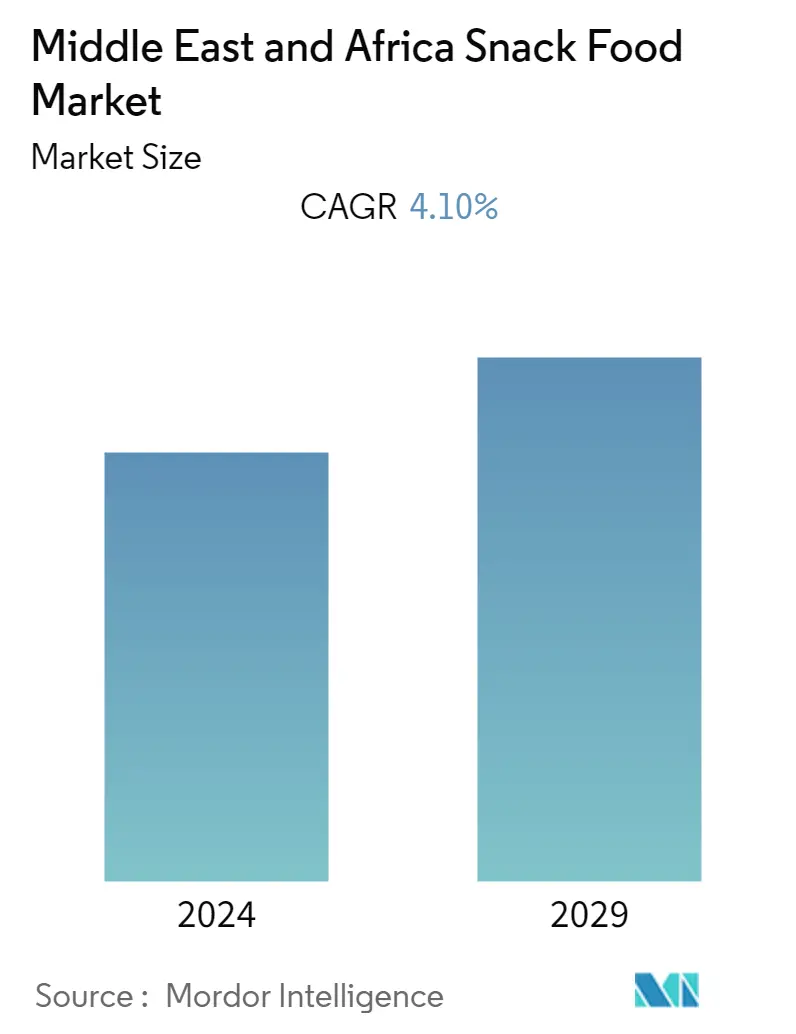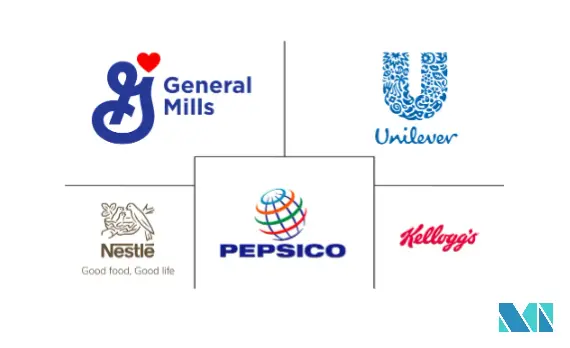Market Size of Middle East & Africa Snack Food Industry

| Study Period | 2019 - 2029 |
| Base Year For Estimation | 2023 |
| Forecast Data Period | 2024 - 2029 |
| Historical Data Period | 2019 - 2022 |
| CAGR | 4.10 % |
| Market Concentration | High |
Major Players
*Disclaimer: Major Players sorted in no particular order |
MEA Snack Food Market Analysis
The Middle East & Africa Snack Food Market is projected to register a CAGR of 4.1% during the forecast period, 2022-2027.
The consumer preference for nutritious and healthy snack food on a regular basis is driving the market. In addition, the robust growth of supermarkets and convenience stores that promote brand visibility is driving the growth of the snack foods market. Snacking is gaining traction in the middle east region during social occasions and the healthier snacking options are becoming more popular as customers become more informed. The region places the greatest emphasis on convenience combined with health benefits. Snacks often include bars with wholegrain wheat and other cereals, although pulse flours, nuts, and organically processed grains are also being used.
Innovative product launches with clean label ingredients are the major strategies adopted by the players in the market. For instance, In 2020, Bake Natur.ly, a 'better snacking' division of Dofreeze LLC and a Dubai-based business, announced the launch of its new muffins, available in Banana with Oats and Chocolate with Oats and White Chocolate Chips flavors.
However, the addition of artificial colors and artificial spices are considered to be unhealthy, leading consumers to have less consumption of excess salty or sweet snacks. Besides this, the growing obesity rate further induces consumers in the middle east to avoid fried, oily snacks, causing hurdle in the market growth of the product.
MEA Snack Food Industry Segmentation
Snack foods are packed with essential nutrients and are often referred to as nutrient-dense snacks. Further, the product scope includes snacks with a low content of saturated fats, added sugar, and sodium. Snacks can be consumed as a simple meal that is quick to cook and eat. The Middle East & Africa snack food market is segmented by type into frozen snacks, savory snacks, fruit snacks, confectionery snacks, bakery snacks, and other types. By distribution channel, the market is segmented into supermarkets and hypermarkets, convenience stores, online retail stores, and other distribution channels. By geography into South Africa, Saudi Arabia, and the Rest of the Middle East & Africa. The report offers market size and forecasts in value (USD million) for the above segments.
| By Type | |
| Frozen Snacks | |
| Savory Snacks | |
| Fruit Snacks | |
| Confectionery Snacks | |
| Bakery Snacks | |
| Others |
| By Distribution | |
| Supermarket & Hypermarkets | |
| Convenience stores | |
| Online retail Stores | |
| Other Distribution Channels |
| By Geography | |
| South Africa | |
| Saudi Arabia | |
| Rest of Middle East & Africa |
Middle East & Africa Snack Food Market Size Summary
The Middle East & Africa snack food market is experiencing a notable expansion, driven by a growing consumer preference for nutritious and convenient snacking options. This trend is supported by the proliferation of supermarkets and convenience stores, which enhance brand visibility and accessibility. As social occasions in the region increasingly incorporate snacking, there is a rising demand for healthier alternatives, such as snacks made with wholegrain wheat, pulse flours, nuts, and organically processed grains. The market is characterized by innovative product launches featuring clean label ingredients, reflecting a shift towards transparency and health-conscious choices. However, concerns over artificial additives and the rising obesity rates are prompting consumers to steer clear of overly salty or sweet snacks, presenting challenges to market growth.
The United Arab Emirates stands out as a key player in the region's snack food industry, with a burgeoning demand fueled by busy lifestyles, urbanization, and a growing professional middle class. The expatriate population, which constitutes a significant portion of the UAE's demographic, is particularly influential in driving demand for diverse and novel snack flavors. The government's support for local food producers through events and exhibitions further bolsters the market. Major multinational companies, including Unilever, Nestle, and PepsiCo, are actively engaging in strategic initiatives such as mergers, acquisitions, and product innovations to enhance their market presence. The competitive landscape is marked by a mix of domestic and international players, all vying for market share in a dynamic and evolving industry.
Middle East & Africa Snack Food Market Size - Table of Contents
-
1. MARKET DYNAMICS
-
1.1 Market Drivers
-
1.2 Market Restraints
-
1.3 Porter's Five Force Analysis
-
1.3.1 Threat of New Entrants
-
1.3.2 Bargaining Power of Buyers/Consumers
-
1.3.3 Bargaining Power of Suppliers
-
1.3.4 Threat of Substitute Products
-
1.3.5 Intensity of Competitive Rivalry
-
-
-
2. MARKET SEGMENTATION
-
2.1 By Type
-
2.1.1 Frozen Snacks
-
2.1.2 Savory Snacks
-
2.1.3 Fruit Snacks
-
2.1.4 Confectionery Snacks
-
2.1.5 Bakery Snacks
-
2.1.6 Others
-
-
2.2 By Distribution
-
2.2.1 Supermarket & Hypermarkets
-
2.2.2 Convenience stores
-
2.2.3 Online retail Stores
-
2.2.4 Other Distribution Channels
-
-
2.3 By Geography
-
2.3.1 South Africa
-
2.3.2 Saudi Arabia
-
2.3.3 Rest of Middle East & Africa
-
-
Middle East & Africa Snack Food Market Size FAQs
What is the current Middle East & Africa Snack Food Market size?
The Middle East & Africa Snack Food Market is projected to register a CAGR of 4.10% during the forecast period (2024-2029)
Who are the key players in Middle East & Africa Snack Food Market?
Nestle, Kellogg's Company, General Mills Inc., Unilever and PepsiCo are the major companies operating in the Middle East & Africa Snack Food Market.

